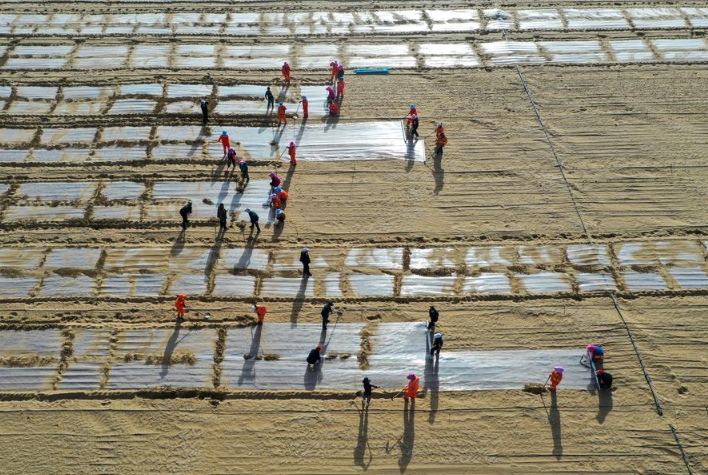Wedoany.com Report-Apr. 15, The Taklimakan Desert, located in northwest China’s Xinjiang Uygur Autonomous Region, spans 337,600 square kilometers with a circumference of 3,046 kilometers. It ranks as China’s largest desert and the world’s second-largest drifting desert. On November 28, 2024, a significant milestone was achieved when decades of sand prevention efforts culminated in the completion of a green belt encircling the entire desert.
An aerial drone photo taken on April 8, 2025 shows people planting coix at a sand industry experimental base in Yutian County of Hotan Prefecture, northwest China's Xinjiang Uygur Autonomous Region.
This green belt, designed to block sand movement, marks a major step in combating desertification. In 2025, Xinjiang plans to afforest approximately 796,000 hectares of land, with 562,666 hectares dedicated specifically to frontline efforts in the Taklimakan Desert. These initiatives are part of the Three-North Shelterbelt Forest Program, recognized as the world’s largest afforestation effort, which focuses on addressing desertification across northwest, north, and northeast China.
The afforestation work aims to strengthen the region’s environmental resilience. By expanding the sand-blocking green belt, Xinjiang seeks to enhance desert containment and promote sustainable land management. These efforts also contribute to improving local livelihoods by creating greener, more stable environments for communities near the desert.
Xinjiang’s authorities emphasized: “Xinjiang will further widen the sand-blocking green belt and enhance desert-locking efforts to achieve sustainable sand control while improving local livelihoods.” This commitment reflects a balanced approach to environmental protection and community well-being.
The ongoing work in the Taklimakan Desert builds on years of expertise in sand control, combining innovative techniques with large-scale planting. The green belt not only curbs the desert’s expansion but also supports biodiversity and reduces the impact of sandstorms in surrounding areas. Through these measures, Xinjiang is fostering a model for sustainable development that aligns with broader ecological goals.
This achievement underscores the importance of long-term environmental planning. The Taklimakan Desert’s green belt serves as a foundation for future afforestation projects, ensuring that the region continues to benefit from improved land quality and ecological stability.











